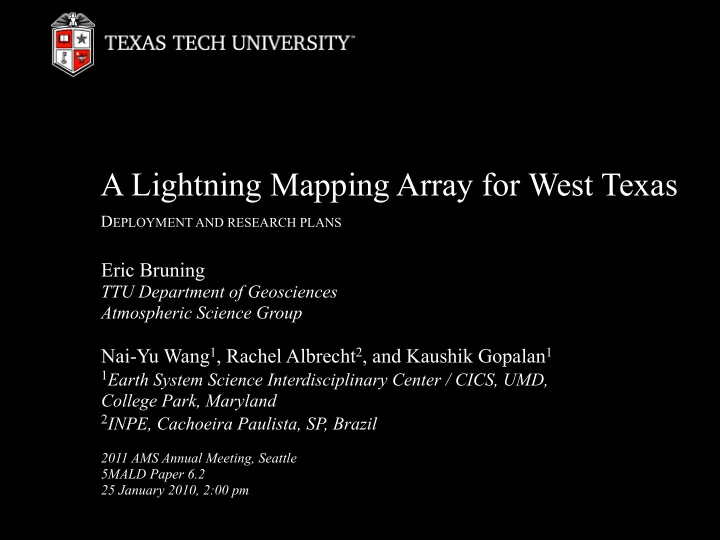

A Lightning Mapping Array for West Texas D EPLOYMENT AND RESEARCH PLANS Eric Bruning TTU Department of Geosciences Atmospheric Science Group Nai-Yu Wang 1 , Rachel Albrecht 2 , and Kaushik Gopalan 1 1 Earth System Science Interdisciplinary Center / CICS, UMD, College Park, Maryland 2 INPE, Cachoeira Paulista, SP, Brazil 2011 AMS Annual Meeting, Seattle 5MALD Paper 6.2 25 January 2010, 2:00 pm
W EST T EXAS LMA West Texas Mesonet Stations and WTLMA 2D Coverage TTU has purchased an LMA for West Texas • Fall 2010: Site surveys • Mid-2011: Install, initial obs 150 km diameter 3D mapping • Cloud electrification research 400 km diameter 2D mapping • Operational applications – Joins networks in OK, AL, DC, KSC, NM – GOES-R GLM Proving Ground • Covers West Texas Mesonet
W EST T EXAS LMA Unique regional coverage with OKLMA • Studies of long- track supercells and MCSs NSF proposal submitted for participation in DC3 campaign • Summer 2012, joint with OU for ballooning obs and SMART-R operations • TTU Ka mobile radars also in the field
LMA: H ARDWARE TTU notional setup 11 Stations (1 spare) 15 km spacing, 60 km network diameter Single tripod-type mount RF-sealed electronics enclosure in shade of solar panels 2-12VDC marine batteries charged by 1-2 solar panels 5.4 GHz wireless modem, 1/4 to 1/2 mi link to wired connection nearby 10 W without wireless modem, (modem adds about 5 W) Recent NMT installation, photo courtesy Ron Thomas
WTLMA P RELIMINARY NOISE SURVEY 1000 trigger/sec threshold (dBm) 5 confirmed sites; good to very good noise levels Will be improved 2 sites ok • will check adjacent farm fields NE Lubbock 4 sites yet to be surveyed
TTU L IGHTNING R ESEARCH O BJECTIVES Relate electrification and lightning morphology to convective storm morphology and kinematic character across scales Exploit detailed resolution of leaders, which respond to electric potential set up by thunderstorm charge structure Where do flashes begin? Where do leaders go? How do the above factors relate to “large” charge transfers and optical flashing?
C HARGE STRUCTURES REFERENCED TO STORM STRUCTURE Stolzenburg et al. (1998b), Synthesis Wiens et al. (2005), Supercell Stolzenburg et al. (1998a), MCS
TTU L IGHTNING R ESEARCH O BJECTIVES Relate electrification and lightning morphology to convective storm morphology and kinematic character across scales Exploit detailed resolution of leaders, which respond to electric potential set up by thunderstorm charge structure Does turbulent convective mixing impact charge structure and electrification mechanisms? • e.g., one- vs. two-cloud lab experiments of Saunders et al. (2006)
A P OSSIBLE T HEORETICAL A PPROACH ( ONGOING WORK ) Apply meteorological idea of frontogenesis ( F ) to electric potential • F =Time rate of change of the gradient of a scalar • Electric potential frontogenesis is time rate of change of the electric field • Electric field “frontogenesis” is time rate of change of charge Dynamics under mass conservation contains deformation, tilting, confluence, and local source • Relate these processes to the formation of potential wells (flash extent) and electric field maxima (flash initiation) A route to link flow geometry, flash morphology, and thunderstorm turbulent dynamics?
22 O CTOBER 2010: K A - BAND SQUALL LINE OBSERVATIONS 0020:55 UTC Initial observations with TTU Ka-band radar suggest we can resolve contrasting eddy & laminar convective flows Next step: compare to lightning measurements from the WTLMA (planned Ka deployments Data courtesy John Schroeder, Scott Gunter and the TTU Ka team through 2012)
E VIDENCE FOR FINE - SCALE ORGANIZATION OF CHARGE : MEAN QUANTITIES VS . LARGE EDDIES AND SCALAR FIELD MORPHOLOGY Supercell, Bruning et al. (2010, MWR) Squall line, Bryan et al. 2003 “Stratiform” “Convective” Fig. 3. Across-line cross sections of equivalent Top: Inferred conceptual model of charge potential temperature ( θ e, in K) from weak structure shear simulations at 180 min using (a) 1000-m Bottom: Observed lightning-inferred charge grid spacing (at y = 45) and (b) 125-m grid corresponding to top left panel. spacing (at y = 49 km)
F LASH FOOTPRINT STATISTICS METHODOLOGY Sort LMA data into flashes 0.15 s and 3 km threshold • Using McCaul et al. (2009) algorithm Flash footprint: area of convex hull of (x,y) event coordinates Events and flash metadata written to HDF5 table for easy query with PyTables Read, query and plot event and flash data Flexible Python pipeline for counting and gridding of any parameter, in any map projection • https://bitbucket.org/deeplycloudy/lmatools/src
10 J UNE 2009 - SQUALL LINE & CELLULAR CONVECTION Flash size spectrum and κ -5/3 line 30 flashes 100 m 1 km 10 km
10 J UNE 2009 - SQUALL LINE & CELLULAR CONVECTION Squall line vertical velocity spectra and κ -5/3 line (Bryan et al. 2003, Fig. A1) Three 125 m simulations with different diffusion coefficients
O VERLAY OF B RYAN ET AL . (2003) AND 10 J UNE 2009
S OME REMARKS ON SIMILARITIES Overall shape of flash size and kinetic energy spectra are very similar Peak in eddy energy spectrum and peak in flash size spectrum are at about the same wavelength (several km) Ostensible κ -5/3 subrange is at a 1 km or less
22 J UNE 2004 - SQUALL LINE & CELLULAR CONVECTION
26 M AY 2004 - LP S UPERCELL
29 M AY 2004 - HP S UPERCELL
Recommend
More recommend